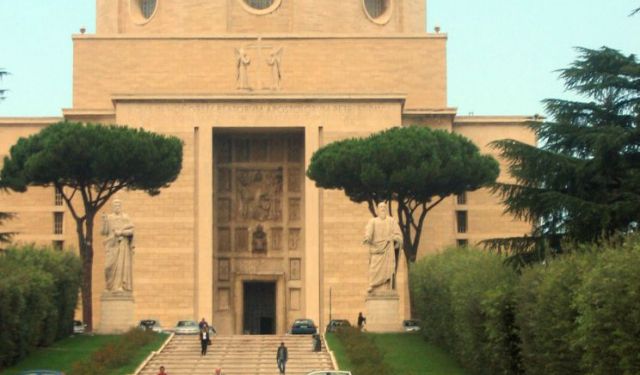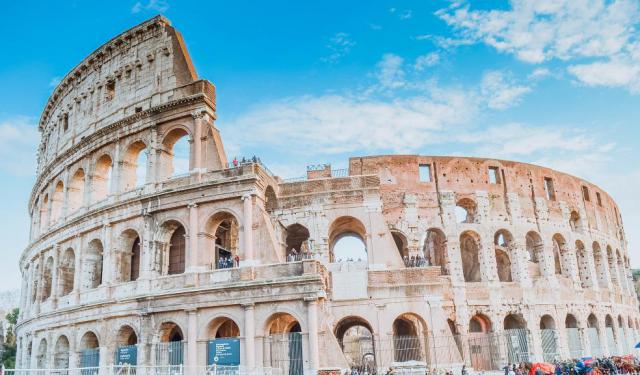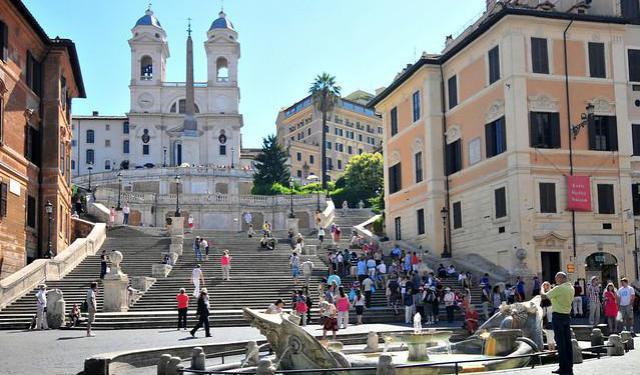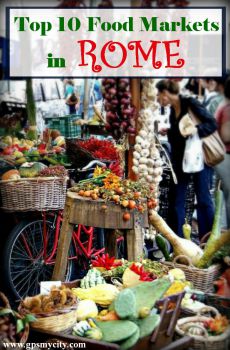
Arco di Costantino (Arch of Constantine), Rome
On October 28, 312 AD, Roman emperor Constantine had an epic battle with his rival, co-emperor Maxentius. It went down in history as the Battle of the Milvian Bridge. Victorious Constantine became the sole ruler of the Roman Empire, thus ending the system of Tetrarchy. He is generally regarded as the last great emperor of Rome.
The Arch of Constantine, Rome’s largest triumphal arch, was dedicated in 315 AD to commemorate Constantine’s victory. Located between the Colosseum and Palatine Hill, it spans the Road of Triumph, marking the route of Roman military parades. The arch stands 21 meters high, featuring three bays and incorporating elements from earlier monuments, including reliefs and statues from the reigns of Trajan, Hadrian, and Marcus Aurelius, reworked to celebrate Constantine.
Scholars have debated the arch's origins, suggesting it may predate Constantine and even have ties to Hadrian’s or Maxentius’s reigns. The arch exemplifies Late Antique artistic styles, with a blend of reused classical Greek-inspired elements and newly-created simpler, symbolic works. Reliefs from earlier monuments display classical proportions and dynamic movement, while the 4th-century additions feature rigid and geometric forms, reflecting changes in artistic priorities or economic constraints at that time. This stylistic contrast highlights the transition from Rome’s classical tradition to the evolving aesthetics of Late Antiquity.
Decorative elements on the arch include reliefs of Dacians from Trajan’s reign, panels depicting Marcus Aurelius’s military campaigns, and roundels from Hadrian’s era reworked to depict Constantine. A Constantinian frieze narrates his campaign against Maxentius, while inscriptions celebrate him as a pious and victorious leader.
One such inscription credits Constantine with saving the Roman people by divine inspiration. It refers to his vision before the Battle of Milvian Bridge in 312 AD, where he claimed to have seen a cross in the sky and heard the words: "In this sign, you will conquer." This event is often linked to Constantine's promotion of Christianity within the Roman Empire. The arch also balances pagan and Christian themes, symbolizing Constantine’s shifting religious stance during this period.
The Arch of Constantine's global influence as a monument includes the likes of the Arch of Triumph in Paris, the Marble Arch in London, Washington Union Station in Washington DC, and the American Museum of Natural History in New York City.
The Arch of Constantine, Rome’s largest triumphal arch, was dedicated in 315 AD to commemorate Constantine’s victory. Located between the Colosseum and Palatine Hill, it spans the Road of Triumph, marking the route of Roman military parades. The arch stands 21 meters high, featuring three bays and incorporating elements from earlier monuments, including reliefs and statues from the reigns of Trajan, Hadrian, and Marcus Aurelius, reworked to celebrate Constantine.
Scholars have debated the arch's origins, suggesting it may predate Constantine and even have ties to Hadrian’s or Maxentius’s reigns. The arch exemplifies Late Antique artistic styles, with a blend of reused classical Greek-inspired elements and newly-created simpler, symbolic works. Reliefs from earlier monuments display classical proportions and dynamic movement, while the 4th-century additions feature rigid and geometric forms, reflecting changes in artistic priorities or economic constraints at that time. This stylistic contrast highlights the transition from Rome’s classical tradition to the evolving aesthetics of Late Antiquity.
Decorative elements on the arch include reliefs of Dacians from Trajan’s reign, panels depicting Marcus Aurelius’s military campaigns, and roundels from Hadrian’s era reworked to depict Constantine. A Constantinian frieze narrates his campaign against Maxentius, while inscriptions celebrate him as a pious and victorious leader.
One such inscription credits Constantine with saving the Roman people by divine inspiration. It refers to his vision before the Battle of Milvian Bridge in 312 AD, where he claimed to have seen a cross in the sky and heard the words: "In this sign, you will conquer." This event is often linked to Constantine's promotion of Christianity within the Roman Empire. The arch also balances pagan and Christian themes, symbolizing Constantine’s shifting religious stance during this period.
The Arch of Constantine's global influence as a monument includes the likes of the Arch of Triumph in Paris, the Marble Arch in London, Washington Union Station in Washington DC, and the American Museum of Natural History in New York City.
Want to visit this sight? Check out these Self-Guided Walking Tours in Rome. Alternatively, you can download the mobile app "GPSmyCity: Walks in 1K+ Cities" from Apple App Store or Google Play Store. The app turns your mobile device to a personal tour guide and it works offline, so no data plan is needed when traveling abroad.
Arco di Costantino (Arch of Constantine) on Map






Sight Name: Arco di Costantino (Arch of Constantine)
Sight Location: Rome, Italy (See walking tours in Rome)
Sight Type: Attraction/Landmark
Guide(s) Containing This Sight:
Sight Location: Rome, Italy (See walking tours in Rome)
Sight Type: Attraction/Landmark
Guide(s) Containing This Sight:
Walking Tours in Rome, Italy
Create Your Own Walk in Rome
Creating your own self-guided walk in Rome is easy and fun. Choose the city attractions that you want to see and a walk route map will be created just for you. You can even set your hotel as the start point of the walk.
EUR Sightseeing Walking Tour
The Esposizione Universale di Roma (EUR), located in the southern suburb of Rome, was originally constructed for an international exhibition that was planned by Mussolini as a grand celebration of Fascist Italy. However, due to the outbreak of World War II, the exhibition never took place. The architecture of EUR was designed to glorify Fascism and showcases a distinct style that sets it apart... view more
Tour Duration: 2 Hour(s)
Travel Distance: 3.6 Km or 2.2 Miles
Tour Duration: 2 Hour(s)
Travel Distance: 3.6 Km or 2.2 Miles
Vatican Walking Tour
Consisting of a walled enclave within the city of Rome, the Vatican is the world’s smallest sovereign state, as well as a symbol (and headquarters) of the Roman Catholic faith. Although only 44 hectares in surface, one is amazed by the vastness of this place and the sheer size of everything. When gazing around in all directions, you realize how much can be achieved by people working in faith for... view more
Tour Duration: 2 Hour(s)
Travel Distance: 3.4 Km or 2.1 Miles
Tour Duration: 2 Hour(s)
Travel Distance: 3.4 Km or 2.1 Miles
Rome Introduction Walking Tour I
Often referred to as the Eternal City, Rome holds a unique place in the story of Western civilization. Its influence shaped European culture through language, governance, and monumental architecture.
The name “Rome” originates from Romulus, the mythical founder of the city, who, according to legend, was the son of the war god Mars and Rhea Silvia, the priestess of goddess Vesta. Both,... view more
Tour Duration: 2 Hour(s)
Travel Distance: 3.3 Km or 2.1 Miles
The name “Rome” originates from Romulus, the mythical founder of the city, who, according to legend, was the son of the war god Mars and Rhea Silvia, the priestess of goddess Vesta. Both,... view more
Tour Duration: 2 Hour(s)
Travel Distance: 3.3 Km or 2.1 Miles
Holy Sites Walking Tour
As the cradle of the Catholic Church, one of the world's largest organizations, Rome has a large number of valuable, sacred places of worship. Crowded with architectural splendors from different periods of time, each of its churches and basilicas represent a significant part of culture and history.
Take this self-guided walking tour to discover Rome's magnificent religious heritage,... view more
Tour Duration: 3 Hour(s)
Travel Distance: 6.9 Km or 4.3 Miles
Take this self-guided walking tour to discover Rome's magnificent religious heritage,... view more
Tour Duration: 3 Hour(s)
Travel Distance: 6.9 Km or 4.3 Miles
Palatine Hill Walking Tour
Palatine Hill is one of the seven hills of Rome and the most ancient part of the capital. Based on Roman mythology and archaeological evidence, this hill is considered the birthplace of the city – a place where legendary Romulus founded it in 753 BC. Furthermore, the very word “palace” – indicating the emperor’s residence (“Palatium”), much as that of other dignitaries and prominent... view more
Tour Duration: 1 Hour(s)
Travel Distance: 1.0 Km or 0.6 Miles
Tour Duration: 1 Hour(s)
Travel Distance: 1.0 Km or 0.6 Miles
Spanish Steps to Trevi Fountain
An established tourist mecca, today's Rome is hardly imaginable without two of its much loved attractions – the Spanish Steps and the Trevi Fountain. Magnets for tourists as they are, these two sights are connected to a number of other, not less worthy of attention locations, such as the Fountain of the Longboat or Piazza Colonna and its centerpiece, the Column of Marcus Aurelius, to... view more
Tour Duration: 1 Hour(s)
Travel Distance: 2.0 Km or 1.2 Miles
Tour Duration: 1 Hour(s)
Travel Distance: 2.0 Km or 1.2 Miles
Useful Travel Guides for Planning Your Trip
Souvenirs Shopping: 15 Authentic Italian Things To Buy in Rome
Rome is the Eternal City and, as such, the list of gift options available here is countless. Whether it's something edible, drinkable, wearable or pleasing to the eye that you want - you will find it all here in abundance. However, if time or budget is the factor, perhaps you might want to...
17 Best Gelaterias in Rome Italy
For ice cream lovers and dabblers this guide is a treasure chest of Rome’s best gelato shops. There are gelaterias everywhere. Many visitors to Rome only have a few days to explore the city. You owe it to yourself to make the most of your time and find the gelato locals eat. Often the authentic...
10 Best Food Markets in Rome Italy
Of all the things Italy is most famous for (cars, music, fashion, movies, etc.), food is, undoubtedly, top of the list. Rome may well not be the whole Italy, but no Italy is whole without Rome... And the Romans, much as all their fellow-Italians, like it "fresco", hence the abundance of...









